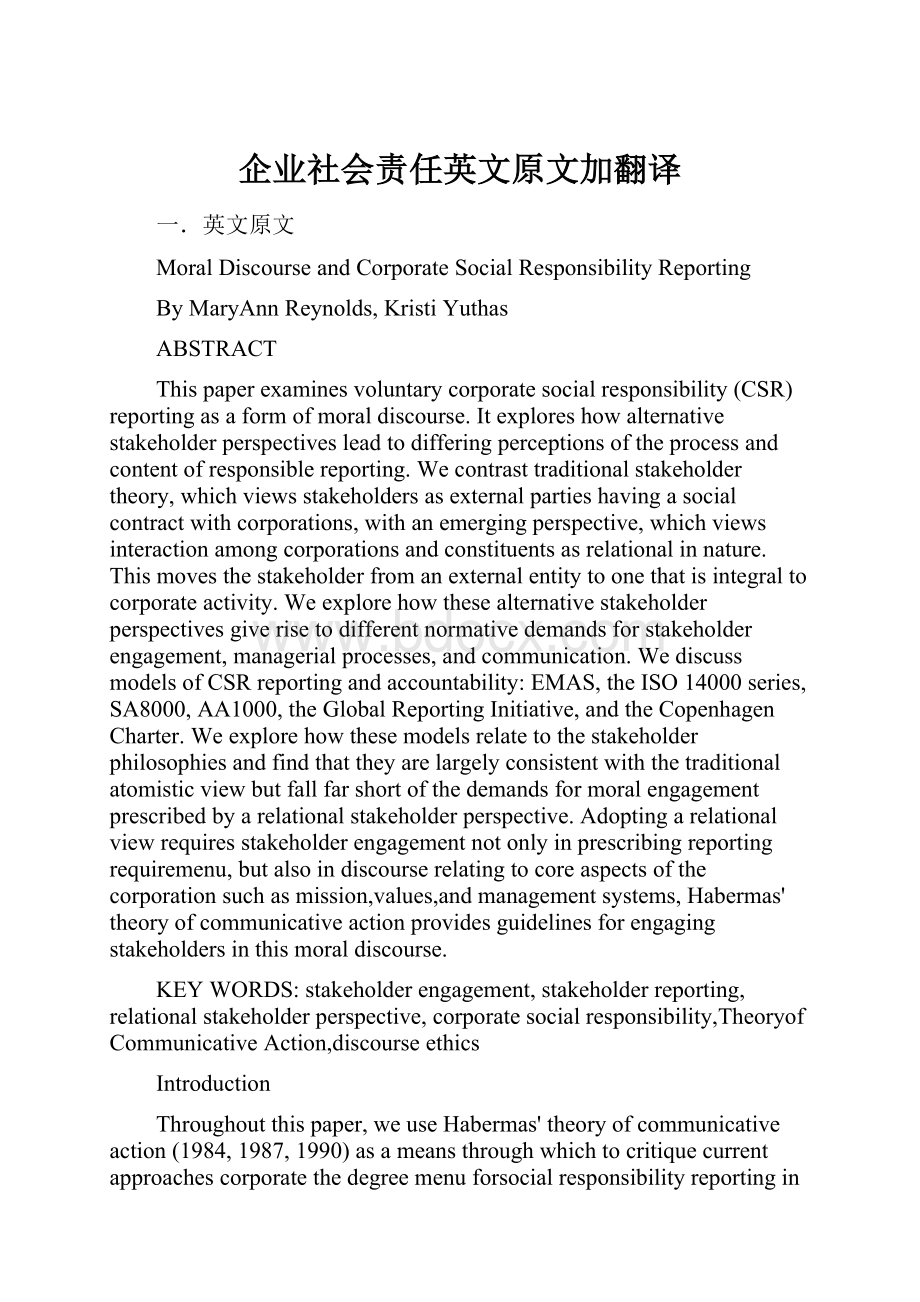企业社会责任英文原文加翻译Word文件下载.docx
《企业社会责任英文原文加翻译Word文件下载.docx》由会员分享,可在线阅读,更多相关《企业社会责任英文原文加翻译Word文件下载.docx(7页珍藏版)》请在冰豆网上搜索。

Thispaperexaminesvoluntarycorporatesocialresponsibility(CSR)reportingasaformofmoraldiscourse.Itexploreshowalternativestakeholderperspectivesleadtodifferingperceptionsoftheprocessandcontentofresponsiblereporting.Wecontrasttraditionalstakeholdertheory,whichviewsstakeholdersasexternalpartieshavingasocialcontractwithcorporations,withanemergingperspective,whichviewsinteractionamongcorporationsandconstituentsasrelationalinnature.Thismovesthestakeholderfromanexternalentitytoonethatisintegraltocorporateactivity.Weexplorehowthesealternativestakeholderperspectivesgiverisetodifferentnormativedemandsforstakeholderengagement,managerialprocesses,andcommunication.WediscussmodelsofCSRreportingandaccountability:
EMAS,theISO14000series,SA8000,AA1000,theGlobalReportingInitiative,andtheCopenhagenCharter.Weexplorehowthesemodelsrelatetothestakeholderphilosophiesandfindthattheyarelargelyconsistentwiththetraditionalatomisticviewbutfallfarshortofthedemandsformoralengagementprescribedbyarelationalstakeholderperspective.Adoptingarelationalviewrequiresstakeholderengagementnotonlyinprescribingreportingrequiremenu,butalsoindiscourserelatingtocoreaspectsofthecorporationsuchasmission,values,andmanagementsystems,Habermas'
theoryofcommunicativeactionprovidesguidelinesforengagingstakeholdersinthismoraldiscourse.
KEYWORDS:
stakeholderengagement,stakeholderreporting,relationalstakeholderperspective,corporatesocialresponsibility,TheoryofCommunicativeAction,discourseethics
Introduction
Throughoutthispaper,weuseHabermas'
theoryofcommunicativeaction(1984,1987,1990)asameansthroughwhichtocritiquecurrentapproachescorporatethedegreemenuforsocialresponsibilityreportingintermstowhichthesereportsembodyrequiremoraldiscourse.Weprovideabriefintroductiontokeyelementsofthetheoryandgrounditinsocialtheory.WethendiscussthedetailsastheyapplytoCSRreporting.
Ouranalysisisconductedintwostages,relyingondifferentportionsofHabermas'
theory.Inthefirstpart,weexaminetheconditionsthatallowforbasiccommunicativeunderstanding.Theseconditionsaretheunspokenassumptionsunderlyingcommunication.Innormalcommunication,fourbasicuniversalassumptionsaremade:
thatthespeakeristellingthetruth,thathemeanswhathesays,andthatwhathesaysisappropriateinitscontext,andthatitisunderstandabletothelistener.Inthefirstpartofthepaper,weshowhowmodelsorframeworksforCSRreporting,takentogether,addresstheseassumptionsandcontributetotheeffectivenessofCSRreportsasaformofcommunication.Inthesecondpartofouranalysis,werelyupontheethicalaspectsofHabermas'
theoryasameansthroughwhichtoprovideanormativecritiqueofthebodyofCSRreportingframeworks.Thetheoryofcommunicativeactionsuggeststhatsocialprogresscanbeaccomplishedthroughrationaldiscourseunderspecificconditions.Thediscoursemustbeinclusive,democratic,andfreeofpowerasymmetries.Apel(1980)hassuggestedthattheethicalnatureofanagreementderivesfromtheprocessusedtoarriveatthatagreement(ratherthanuniversalorexternally-imposedethicalstandards).WeuseHabermas'
principlesasameanstoexaminetheextenttocorporatecommunicationisreflectiveofmoraldiscourse.Wefindthatwhiletheframeworksgenerallypromotestakeholderconsultation,theyfallshortofprovidingotherconditionsneededformoraldiscourse.Inparticular,theyfailtoprovidemechanismsthatallowstakeholderswithdifferingresourcestoparticipatedemocraticallyindiscourse.
Thepaperisorganizedasfollows.First,weintroducesocialresponsibilityandcorporatedisclosureconceptsrelatedtoCSRreporting.Next,weexplorewidely-usedframeworksassociatedwithcorporateaccountabilityintheCSRrealm.Then,asnotedabove,weprovidea2-partanalysisofhowconceptsfromHabermas'
theoryofcommunicativeactionarecurrentlyrealizedinguidanceprovidedbyCSRreportingmodels.Weclosewithconcludingremarks.
Background:
socialresponsibilityandcorporatedisclosure
Corporatesocialresponsibilityisaddressedincurrentbusiness,accountingandethicsliterature.Theissue
waswidelydiscussedintheseventiesandearlyeightiesandthendroppedoutofsight.Thecurrentre-energizedfocusincludessocial,environmentalandethicalreportingbycorporations.Thenotionofcorporatesocialdisclosurearisesfromaviewofsocialtheorywhichholdsthatthecorporationowesadutytothesociety;
orhasasocialcontract.OnewidelycitedquotationcomesfromShockerandSethi(1974,p.67):
"
Anysocialinstitution一andbusinessinnoexception一operatesinsocietyviaasocialcontract,expressedorimplied,wherebyitssurvivalandgrowtharebasedon:
1.Thedeliveryofsomesociallydesirableendstosocietyingeneraland,
2.Thedistributionofeconomic,socialorpoliticalbenefitstogroupsfromwhichitderivesitspower.
Inadnamicsociety,neitherthesourcesofinstitutionalpowernortheneedsforitsservicesarepermanent.Therefore,aninstitutionmustconstantlymeetthetwintestsoflegitimacyandrelevancebydemonstrafingthatsocietyrequiresitsservicesandthatthegroupsbenefitingfromitsrewardshavesociety'
sapproval."
CarrollandBucholtzofferafourpartdefinitionofcorporatesocialresponsibility,"
Thesocialresponsibilityofbusinessencompassestheeconomic,legal,ethical,anddiscretionary(philanthropic)expectadonsthatsocietyhasoforganizationsatagivenpointintime(2006,p.35)."
Thisdefinitionreflectscurrentthinkingoncorporatesocialresponsibilityandacknowledgestheneedtonoteshiftsinsocialenvironment,thesemaybesocial,legal,orpolitical.
Corporateinvestorsarequestioningtheadequacyofthiscommunicationapproachandhavecalledforincreasedreportingonissuesofbroadsocietalinterest.Presentlyitisestimatedthattrillionsofdollarsareallocatedtoinvestmentsbasedonsomesocialcriteria(SparkesandCowton,2004).Confulionmayarisewiththelackofcomparablereporting.Implementableguidelineshaveconsequentlybeendevelopedbygroupsproposingmodelsorframeworksforreporting(communicating)andauditing(verifying).Leadingexamplesinordertheywerefirstissuedare:
EMAS(European,particularlyGermanenvironmentalmanagementandaudit)
ISO14001(Internationallyrecognizedenvironmentalmanagementcertification)
SA8000(SocialAccountabilityInternationallaborstandard).
AA1000(Internationalaccountabilityassurantereportingstandard).
CopenhagenCharter(Internationalstandardinvolvingstakeholdercommunications).
GRI(GlobalReportingInitiative)2000(Internationalsustainabilityreport).
Modelsforcorporatesocialresponsibilityreporting
Approachestosocialandnaturalenvironmentalaccountabilityhavebeendevelopedforvariouspurposes.ClassifyingthemundertheumbrellaofCSRreportingwewilldiscusssomewidelyusedmodelsandintroducealesswell-knownmodel,whichmayprovideadditionalbenefit.
Eco-ManagementandAuditScheme(EMAS,1995,2001)
TheEuropeanCommissionsetdownthebasicprinciplesunderlyingtheEMASschemeinCouncilRegulation1836/93-EMASoftheEuropeanCommission.Thepurposewasimprovementofenvironmentalperformanceandwasinitiallydirectedatmanufacturingfirms.Thishassincebeenextendedtoallowbroadparticipationbyanypublicorprivateentitywishingtoparticipate.Theregulationcallsforanenvironmentalstatementfromtheentityandrequiresauditing.Further,thereisacontinualrequirementtodocumentongoingcontinualimprovementthroughtheofimplementationpolicies,programmesandmanagementsystemsbyasystematic,objective,andperiodicevaluationofperformance.Thereisalsoanobligationtoinformthepublicoftheresultsoftheevaluation.
ThearticleonparticipationstatesthattheschemeisopentopublicorprivateentitiesoperatingintheEUortheEuropeanEconomicArea(EEA).Thesitemayberegisteredifthesitehasanenvironmentalpolicy,asitereview,anenvironmentalaudit,objectivesforcontinuousimprovement,astatementfromeachsite,verificationcoveringpoficy,programmes,themanagementsystem,thereviewandauditprocedure,andthestatementprovided.ThevalidatedenvironmentalstatementisthenforwardedtothecompetentbodyintheMemberState.Thestatementisalsodisseminatedtothepublicaftertheregistrationofthesitehasbeencompleted.Thestatementshouldbeaconcise,comprehensibledescriptionofactivitiesatthesite;
withanassessmentofsignificantrelevantenvironmentalissues,including:
emissions,wastegeneration,consumptionofrawmaterials,energyandwater,noiseandothersignificantaspects;
apresentationofthecompany'
senvironmentalpoficy,programmeandmanagementsystematthesite,thedeadlineforthenextstatement,andthenameoftheaccreditedenvironmental
verifier.TheEMAS2001wasstrengthenedbyrequiringISO14001astheenvironmentalmanagementsystem.
CouncilonEconomicPrioritiesAccreditationAgencySocialAccountabilityStandard(SA8000,1998)/renamedSocialAccountabilityInternational(SAI)
Thisstandardhasachangeinfocusandisconcernedwithfairlaborpracticesworldwide.Itisdividedintopurposeandscope,normativeelementsandtheirinterpretation,definitions,andsocialaccountabilityrequirements.Thesocialaccountabilityrequirementsinclude:
childlabor,forcedlabor,healthandsafety,freedomofassocianon